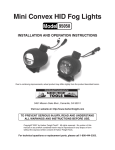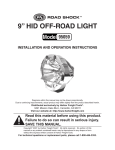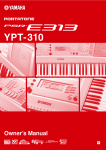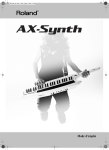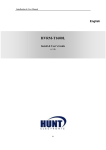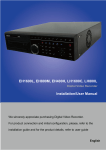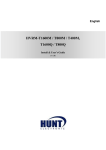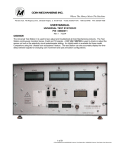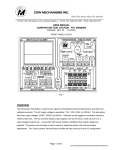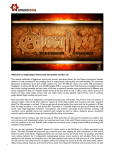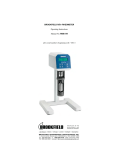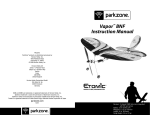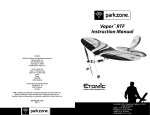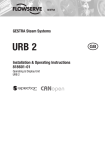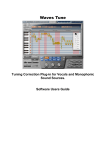Download TBX1 user manual
Transcript
Ηπ INSTRUMENTS hpi.zentral.zone · T U N I N G BOX TBX1 · User Manual 1 CONTENTS 1. Introduction................................................................................................................................. Checklist .............................................................................................................................. Top Panel Diagram .............................................................................................................. Rear Panel Diagram ............................................................................................................. 2 3 4 5 2. Setups ......................................................................................................................................... 5 Compatibility Requirements .................................................................................................. 6 Startup Sequence ............................................................................................................... 6 Keyboard Synthesizer .......................................................................................................... 7 Keyboard Controller and External Tone Module ................................................................... 7 Computer with Internal Sound Card, Software Synthesizer or Sampler and Controller .......... 8 Computer and Keyboard Synthesizer, Recording Pitches Sounding ..................................... 9 Computer and Keyboard Synthesizer, Recording Keys Played ........................................... 10 Computer, Controller and Tone Module, Recording Pitches Sounding ............................... 11 Computer, Controller and Tone Module, Recording Keys Played ....................................... 12 3. Tuning Tables ........................................................................................................................... Table Layers ...................................................................................................................... Programming a Tuning Table ............................................................................................. Sharing a Tuning ............................................................................................................... 12 13 13 14 4. Polyphony ................................................................................................................................ 14 5. Presets ..................................................................................................................................... 15 Storing a Preset ................................................................................................................. 15 6. Sequencer / MIDI Footswitch Control ....................................................................................... Patch Change ................................................................................................................... Bank Select ....................................................................................................................... Tuning Table Change ........................................................................................................ 16 16 16 16 APPENDIX..................................................................................................................................... 17 Bank Select DIP Switch Settings ........................................................................................ Pitch Bend Response Timing DIP Switch Settings .............................................................. Sysex Retransmission DIP Switch Setting .......................................................................... MIDI Implementation Chart ................................................................................................ Possible Tuning Resolutions .............................................................................................. System Exclusive Messages ............................................................................................. Troubleshooting ................................................................................................................ Technical Specification ...................................................................................................... 17 18 18 19 20 21 22 24 Ηπ INSTRUMENTS hpi.zentral.zone · T U N I N G BOX TBX1 · User Manual 2 1. Introduction The H-Pi Instruments Tuning Box TBX1 has been designed to be portable, easy to use, and compatible with the widest range of existing MIDI hardware and software. TBX1 can be your gateway into a wider world of music making, allowing you to explore the virtually limitless universe of alternative tunings. Please refer to this manual to make sure you get the most out of your TBX1. This manual is Version 2, uploaded March 2015, and applies to all TBX1 units sold after December 31, 2008. Functions described here for Sequencer / MIDI Footswitch Control (see Section 6), DIP Switches (see Appendix), and MIDI Implementation differ from those for TBX1 units sold before August 1, 2007. If you purchased TBX1 prior to January 1, 2009 and are experiencing any problems whatsoever with MIDI implementation, please contact H-Pi Instruments via email at [email protected] This manual may be updated at any time, and your input is appreciated. If you have a question or comment about something in this manual, or something which is not addressed in this manual, please contact us via email at [email protected]. For the latest manual, please visit the H-Pi Instruments website at hpi.zentral.zone Ηπ INSTRUMENTS hpi.zentral.zone · T U N I N G BOX TBX1 · User Manual 3 Checklist TBX1 Every TBX1 unit is built by hand, assembled and tested by the inventor. Please do not be alarmed by any small blemishes you may find. Always handle the unit with care! 9-12V 500mA Power Supply This power supply runs on 100 - 240V, 50 - 60Hz, 0.3A, and will work in most countries around the world – just snap in the locally supported connector. If your connector is not included, an inexpensive adapter should be available locally. Alternatively, TBX1 also runs on 6 AA batteries (not included). Two MIDI cables Having these items, you are ready to begin exploring TBX1. Ηπ INSTRUMENTS hpi.zentral.zone · T U N I N G BOX TBX1 · User Manual 4 Top Panel Diagram MIDI traffic LEDs LCD Backlight Switch These light up when a MIDI message is received or sent. Use them to verify that MIDI connections have been made properly, and to help diagnose any problems with MIDI input or output. Turns LCD illumination on or off. When using batteries, switch the backlight off to conserve battery power. 2 x 16 Character LCD Displays the currently selected preset tuning table, bank, patch, preset, and polyphony. 16 Channel Switches Bypass Switch Use these switches to control polyphony – which channels receive retuned MIDI output. Allows TBX1 tuning function to be disabled without having to power down and change cables. 15 Preset Buttons Press these buttons to recall a preset tunig table, bank, and patch. Programmer When pushed and released, the currently selected preset can be programmed. First, a tuning is chosen, then a bank and patch. When pushed and held for 4 seconds, the currently selected tuning table is sent to MIDI OUT. Use this for sharing tunings or uploading tunings to a computer. Ηπ INSTRUMENTS hpi.zentral.zone · T U N I N G BOX TBX1 · User Manual 5 Rear Panel Diagram 9-12V DC Input When a wall transformer power supply is connected, battery power is bypassed. ON / OFF Switch Turn the unit off when it is not in use. Leaving the unit on for prolonged periods of time may result in damage. MIDI THRU MIDI OUT MIDI IN This output sends MIDI data received at MIDI IN through unmodified to another MIDI device. Connect a synthesizer, sampler or MIDI interface to this jack to receive retuned MIDI data on selected MIDI channels at the selected tuning resolution. Connect a MIDI controller to this jack, also used for uploading tuning tables to TBX1. 2. Setups This section gives instructions for TBX1 MIDI connections in several possible situations. This is not an exhaustive list. You may find other ways of using TBX1. Ηπ INSTRUMENTS hpi.zentral.zone · T U N I N G BOX TBX1 · User Manual 6 Compatibility Requirements Controllers All MIDI controllers connected to MIDI IN will be compatible with TBX1. The diagrams in this manual show keyboard controllers, but other controllers can be used, such as a wind controller or MIDI guitar. Synthesizers and Samplers Connected synthesizers should be MULTI-TIMBRAL. Check the MIDI Implementation Chart of any synthesizer you will be connecting to TBX1 MIDI OUT. The following parameters must be there: YOUR SYNTHESIZER’S MIDI IMPLEMENTATION CHART FUNCTION TRANSMITTED RECOGNIZED REMARKS Pitch Bend (X or O) O Channels 1-16 Control Change 6 100, 101 (X or O) (X or O) O O Data Entry MSB RPN MSB, LSB Aux LOCAL ON/OFF (X or O) (X or O) * Keyboard Synthesizers Only MODE 1: OMNI ON, POLY X = No O = Yes LOCAL ON/OFF may or may not be listed on the chart. LOCAL OFF is only necessary for a setup using a keyboard synthesizer. The chart may also indicate some menu settings on your synthesizer which you will need to configure to satisfy the requirements outlined above. Once this is done, plug in MIDI cables as shown below for your desired setup. NOTE: If MIDI Pitch Bend messages are not recognized, the device will not be retuned! Startup Sequence The following startup sequence should be used with TBX1 and anything connected to it: 1. Turn on TBX1 2. Turn on everything else NOTE: TBX1 may not respond to anything if it is turned on after an Active Sensing controller is turned on. hpi.zentral.zone · T U N I N G Ηπ INSTRUMENTS BOX TBX1 · User Manual 7 Keyboard Synthesizer The simplest TBX1 setup involves a keyboard synthesizer with MIDI setting LOCAL CONTROL OFF, ideal for using TBX1 in live performance situations. Two MIDI cables are required. 1 2 1. Keyboard MIDI OUT to TBX1 MIDI IN 2. TBX1 MIDI OUT to Keyboard MIDI IN If the keyboard has powered speakers, the setup is finished, otherwise add headphones or amplifier. NOTE: Affordable keyboard synthesizers compatible with TBX1, which have powered speakers and which run on batteries, include Yamaha PSR-E213 (also known as YPT-210) and Yamaha PSR-E313 (shown above, also known as YPT310). To learn more about compatible keyboards, visit hpi.zentral.zone Keyboard Controller and External Tone Module 3 2 1 1. Keyboard MIDI OUT to TBX1 MIDI IN 2. TBX1 MIDI OUT to Tone Module MIDI IN 3. Tone Module STEREO OUT to headphones or LINE OUT to amplifier. Ηπ INSTRUMENTS hpi.zentral.zone · T U N I N G BOX TBX1 · User Manual 8 Computer with Internal Sound Card, Software Synthesizer or Sampler and Controller This setup is recommended if you use internal sounds from your computer's sound card, software synthesizer, or software sampler. This arrangement is useful when working with sequencing and notation programs to record retuned MIDI input, or in live performance situations using a laptop. Two MIDI cables and a 1x1 MIDI Interface are required. 3 2 1 4 1. 2. 3. 4. Keyboard MIDI OUT to TBX1 MIDI IN TBX1 MIDI OUT to MIDI Interface MIDI IN MIDI Interface relay to Computer Sound Card, Software Synthesizer or Sampler Computer Audio STEREO OUT to Headphones or LINE OUT to Amplifier Ηπ INSTRUMENTS hpi.zentral.zone · T U N I N G BOX TBX1 · User Manual 9 Computer and Keyboard Synthesizer, Recording Pitches Sounding This setup is recommended if you want to send MIDI to your computer and use the sounds from your keyboard's internal synthesizer or sampler. This arrangement is useful when working with sequencing and notation programs to record retuned MIDI input. The keyboard must use MIDI setting LOCAL CONTROL OFF. Three MIDI cables and a 1x1 MIDI Interface are required. 3 2 4 1 1. 2. 3. 4. Keyboard MIDI OUT to TBX1 MIDI IN TBX1 MIDI OUT to MIDI Interface MIDI IN MIDI Interface relay to Computer MIDI Interface MIDI OUT to Keyboard MIDI IN If the keyboard contains powered speakers, the setup is finished, otherwise add headphones or an amplifier. Ηπ INSTRUMENTS hpi.zentral.zone · T U N I N G BOX TBX1 · User Manual 10 Computer and Keyboard Synthesizer, Recording Keys Played Equipment can be arranged to send unmodified (untuned) MIDI directly from your keyboard to your computer while sending modified (tuned) MIDI from TBX1 to the keyboard synthesizer or sampler and on to your headphones or amplifier. When using a notation program this would result in conventional notation corresponding to the keys played rather than the retuned pitches sounding. This setup also allows your computer to send untuned MIDI data to TBX1, which may be useful when working with sequencing or notation programs. Three MIDI cables and a 1x1 MIDI Interface are required. 2 1 3 4 1. 2. 3. 4. Keyboard MIDI OUT to MIDI Interface MIDI IN MIDI Interface relay to Computer MIDI Interface MIDI OUT to TBX1 MIDI IN TBX1 MIDI OUT to Keyboard MIDI IN If the keyboard contains powered speakers, the setup is finished, otherwise add headphones or an amplifier. Ηπ INSTRUMENTS hpi.zentral.zone · T U N I N G BOX TBX1 · User Manual 11 Computer, Controller and Tone Module, Recording Pitches Sounding This setup is recommended if you want to send MIDI to your computer while using sounds from an external hardware synthesizer or sampler. This arrangement is useful when working with sequencing and notation programs to record retuned MIDI input. Three MIDI cables and a 1x1 MIDI Interface are required. 2 3 4 1 5 1. 2. 3. 4. 5. Keyboard MIDI OUT to TBX1 MIDI IN TBX1 MIDI OUT to MIDI Interface MIDI IN MIDI Interface relay to Computer MIDI Interface MIDI OUT to External Tone module MIDI IN External Tone Module STEREO OUT to Headphones or LINE OUT to Amplifier Ηπ INSTRUMENTS hpi.zentral.zone · T U N I N G BOX TBX1 · User Manual 12 Computer, Controller and Tone Module, Recording Keys Played Equipment can be arranged to send unmodified (untuned) MIDI directly from your keyboard to your computer while sending modified (tuned) MIDI from TBX1 to the external module and on to your headphones or amplifier. When using a notation program this would result in conventional notation corresponding to the keys played rather than the retuned pitches sounding. This setup also allows your computer to send untuned MIDI data to TBX1, which may be useful when working with sequencing or notation programs. Three MIDI cables and a 1x1 MIDI Interface are required. 1 2 3 4 5 1. 2. 3. 4. 5. Keyboard MIDI OUT to MIDI Interface MIDI IN MIDI Interface relay to Computer MIDI Interface MIDI OUT to TBX1 MIDI IN TBX1 MIDI OUT to External Tone Module MIDI IN External Tone Module STEREO OUT to Headphones or LINE OUT to Amplifier 3. Tuning Tables Each tuning table provides a simple 1 to 1 correspondence between MIDI Notes input into retuned MIDI Notes output. Any MIDI Note input can be retuned to any pitch output, in any register with any frequency, limited only by the synthesizer connected to the MIDI OUT port. MIDI Note IN Tuning Table lookup Tuned MIDI Note OUT Ηπ INSTRUMENTS hpi.zentral.zone · T U N I N G BOX TBX1 · User Manual 13 There are 128 memory locations, numbered 0 - 127, available for storing tuning tables. The default tuning tables may be overwritten, and there are no protected memory locations. Each table is given a 16-character name. The name and number of the currently selected tuning table is displayed on the LCD. For each MIDI Note, there are three values stored in the tuning table: MIDI Note, Pitch Bend MSB and Pitch Bend LSB. When a MIDI Note ON message is received, these values are looked up and immediately transmitted to MIDI OUT in the following order: Pitch Bend MSB, Pitch Bend LSB, MIDI Note ON. Table Layers Each tuning table is made up of 4 layers of 128 pitches each, totaling 512 pitches per table. 128 tables x 4 layers = 512 full MIDI range tunings (65,536 notes!) stored in memory. Each layer is accessed on a different MIDI channel. When a MIDI Note ON message is received at MIDI IN, corresponding MIDI Note and Pitch Bend Data are looked up from the table layer having the same number as the MIDI channel number of the received message, with MIDI channels 5-8, 9-12, and 1316 remapped as 1-4. Stated another way, the tuning table layer which is accessed corresponds to the sending MIDI channel of the MIDI controller connected to MIDI IN on TBX1, and incoming channels greater than 4 are remapped starting at layer 0. If input is received on multiple MIDI Channels, then the corresponding multiple table layers will be accessed. Channels 1, 5, 9, 13 MIDI Notes IN Channels 2, 6, 10, 14 Channels 3, 7, 11, 15 Layer 1 Tuning Table lookup Channels 4, 8, 12, 16 Tuned MIDI Notes OUT Layer 2 Layer 3 Layer 4 For example, if a controller connected to TBX1 sends Note messages on MIDI Channel 1, then Note and Pitch Bend data is only looked up from tuning table Layer 1. Channel 1 Layer 1 MIDI Notes IN Tuning Table lookup Tuned MIDI Notes OUT Programming a Tuning Table Programming a tuning table means storing it in memory at one of 128 possible locations. Tables are programmed using Custom Scale Editor (CSE) software, available from the H-Pi website. Please see the software documentation for information on creating and programming tuning tables. Ηπ INSTRUMENTS hpi.zentral.zone · T U N I N G BOX TBX1 · User Manual 14 Sharing a Tuning Tuning tables may be sent from one TBX1 to another, using a Tuning Dump, which takes about 2 minutes. Simply connect MIDI OUT from the TBX1 containing the tuning table you want to transfer to MIDI IN on another TBX1 unit which you want to program, and press and hold the PROGRAMMER knob on the first unit for 4 seconds. The table will be sent from the first unit to the second. 4. Polyphony TBX1 achieves microtonal polyphony through a MIDI channel assignment system, called a dynamic channel allocation algorithm. Each retuned MIDI Note requires its own MIDI channel. Therefore, polyphony is limited to 16 voices according to the present MIDI standard. MIDI Notes IN Tuning Table lookup Channels 1, 5, 9, 13 Layer 1 Channels 2, 6, 10, 14 Layer 2 Channels 3, 7, 11, 15 Layer 3 Channels 4, 8, 12, 16 Layer 4 Tuned MIDI Notes OUT Dynamic Channel Allocation Channel 1 Channel 2 Channel 3 Channel 4 Channel 5 Channel 6 Channel 7 Channel 8 Channel 9 Channel 10 Channel 11 Channel 12 Channel 13 Channel 14 Channel 15 Channel 16 You control which channels receive retuned MIDI output with the 16 channel switches. For example, if channels 3, 4, 5 and 6 are engaged and all other channels are disengaged, MIDI Notes will only be sent on channels 3, 4, 5, and 6. Such control is particularly useful for sequencing multitimbral music. MIDI Notes IN Tuning Table lookup Channel 1 Layer 1 Dynamic Channel Allocation Tuned MIDI Notes OUT Channel Channel Channel Channel 3 4 5 6 NOTE: MIDI channel 10 is reserved for percussion sounds on General MIDI synthesizers. To remind you of this, the channel 10 button is colored gray rather than black, and the number is underlined. If you hear a percussion sound every few notes, then you need to disengage channel 10. Ηπ INSTRUMENTS hpi.zentral.zone · T U N I N G BOX TBX1 · User Manual 15 5. Presets A preset consists of a tuning table, bank, and patch which can be recalled at the touch of a button. You can arrange up to 15 different combinations of tunings and sounds for instant recall. Presets numbered above 9 are labeled with the letters A, B, C, D, and E. Storing a Preset Push and turn the PROGRAMMER knob to browse and store preset combinations. Pressing the knob initiates the process of browsing preset parameters, which are programmed in this order: tuning table, bank, and patch. Browse each parameter by turning the knob, and choose values by pressing the knob. While browsing a parameter, that parameter flashes on the display. To store a preset, follow these steps: (1) (2) (3) (4) (5) (6) (7) (8) Select a preset to alter by pushing a preset button. Push the PROGRAMMER knob. The tuning table name and number flash. Turn the knob to find the desired tuning table. Select a tuning table by pressing the knob. The bank number flashes. Turn the knob to find a desired bank. OFF means no bank message will be sent. Select a bank by pressing the programmer knob. The patch number flashes. Turn the knob to find a desired patch. OFF means no patch message will be sent. Select a patch by pressing the knob. The preset is stored. The process above may be canceled at any moment by pressing any preset button. In this case the display stops flashing and preset programming stops. Programming may be initiated again according to the steps above. NOTE: Bank Select messages are handled differently by different manufacturers. TBX1 includes DIP switches for selecting the correct format for your synthesizer. Consult the Appendix for more information on Bank Select DIP switch settings. Ηπ INSTRUMENTS hpi.zentral.zone · T U N I N G BOX TBX1 · User Manual 16 6. Sequencer / MIDI Footswitch Control TBX1 can receive MIDI instructions remotely from many kinds of controllers, including sequencers, notation programs and MIDI footswitches. In addition to NOTE ON and NOTE OFF messages, TBX1 responds to other MIDI messages which can be used to control the currently selected bank, patch, and tuning table independent of TBX1 physical controls. This way, MIDI sequences and live performances can employ a number of different patches and tunings without ever having to touch the controls on TBX1. For this reason we will refer to such control as Remote (not to be confused with wireless control). Patch Changes TBX1 responds to remote messages received on any channel. One simple message recognized is Patch Change, which is Status byte 192-208 for channels 1-16. The Status byte should be followed by one Data byte. The MIDI message format for this message is shown below. Patch Change on Channel (192 - 208 = 1 - 16), Patch (0-127) Bank Select TBX1 responds to several MIDI Continuous Controller (CC) messages. Controller messages are MIDI Status bytes 176-190 for channels 1-16. The Status byte should be followed by a Controller ID byte and then a Data byte. Bank Select MSB and LSB messages are both recognized. Controller on Channel (176 - 190 = 1 - 16), Bank Select MSB, LSB (0, 32), Bank (0-127) TBX1 must be configured to send Bank Select messages in the format recognized by your synthesizer, and this format is used by TBX1 for both sending and receiving Bank Select messages. For more information, see the Appendix: Bank Select DIP Switch Settings. Tuning Table Changes Other controller messages allow remote selection of TBX1 tuning tables. Three messages are available which differ in the way that held notes are handled. These are Undefined Controllers, numbers 116-118 (formerly 80-82). A Controller Status byte is followed by an ID byte and Data byte. Controller on Channel (176 - 190 = 1 - 16), Controller ID (116-118), Tuning Table (0-127) If notes are sustaining in one tuning and you want them to remain sounding in that tuning even after the tuning table has been changed, use Controller ID number 116. If instead you want held notes to change immediately to a new tuning, you have two options. The first is Controller ID number 117 in which notes currently sounding are restruck with pitches in the new tuning. Controller ID number 118 shifts (bends) currently held notes to new pitches without restriking, but the changes in pitch for each note are limited within the range of a 12ET halfstep. Ηπ INSTRUMENTS hpi.zentral.zone · T U N I N G BOX TBX1 · User Manual 17 APPENDIX Bank Select DIP Switch Settings According to the MIDI Specification, manufacturers may use Bank Select messages CC0 or CC32, or both. TBX1 sends Bank Select messages to MIDI OUT, and also recognizes Bank Select messages received at MIDI IN. If you find that banks are not being handled correctly, the TBX1 DIP switches should be adjusted. Only switches 1 and 2 are used for the Bank Select message. The switches are located under the battery compartment lid. With only 4 possible combinations, trial and error may be faster than digging for information in your synthesizer manual. ON 1 ON 2 3 4 DIP Switches ON 1 2 1 2 3 4 1 2 3 4 Default: Bank Select CC0 Option: Bank Select CC32 1 OFF : One byte message 2 OFF : Message is CC0 1 OFF : One byte message 2 ON : Message is CC32 ON ON 3 4 1 2 3 4 1 2 3 4 Option: Bank Select CC0, CC32 Option: Bank Select CC32, CC0 1 ON : Two byte message 2 OFF : Message is CC0, CC32 1 ON : Two byte message 2 ON : Message is CC32, CC0 NOTE: TBX1 must be rebooted for new DIP switch settings to take effect. hpi.zentral.zone · T U N I N G Ηπ INSTRUMENTS BOX TBX1 · User Manual 18 Pitch Bend Response Timing DIP Switch Settings Synthesizers from various manufacturers respond differently to Pitch Bend messages in terms of timing. In order to produce pitches always sounding properly tuned, such that the Pitch Bend is not audible after a note has begun sounding, TBX1 sends MIDI Pitch Bend messages before MIDI Note messages with a default timing gap of less than 5 milliseconds between the two messages. This gap is well below the average perceptual threshold (some sources place this threshold as high as 35 ms). In some cases, a synthesizer or sequencer might quantize the timings of incoming MIDI data such that the default gap is not enough, and a pitch may bend audibly after it is sounding, even though the Pitch Bend message was sent in advance of the Note message. In this case, the Pitch Bend Response Timing DIP switch should be adjusted. Switch 3 is used for this purpose. Timing may be adjusted from the default of less than 5 ms to 30 ms, as shown below. ON ON 1 2 1 2 3 4 1 2 3 Default: ~ 5 ms Option: ~ 30 ms 3 OFF : ~ 5 ms 3 ON : ~30 ms 4 NOTE: TBX1 must be rebooted for new DIP switch settings to take effect. Sysex Retransmission DIP Switch Setting By default, TBX1 ignores all sysex messages which are not table programming messages (see p. 21); however, you may want TBX1 to retransmit other sysex messages which it receives. Switch 4 is used for this purpose. Retransmitted messages include a 120 ms recovery timing gap, for compatibility with older equipment. Always turn this switch OFF and reboot before programming tuning tables. ON ON 1 2 1 2 3 4 1 2 3 4 Default: Sysex Retransmit OFF Option: Sysex Retransmit ON 4 OFF : No Sysex Retransmission 4 ON : (120 ms Recovery Timing) NOTE: ON may cause tuning errors! Always turn switch 4 OFF before sending tuning tables. TBX1 must be rebooted for new DIP switch settings to take effect. Ηπ INSTRUMENTS hpi.zentral.zone · T U N I N G BOX TBX1 · User Manual 19 TBX1 MIDI Implementation Chart FUNCTION TRANSMITTED RECOGNIZED REMARKS Note ON O O1 Channels 1-16 Note OFF O O1 Channels 1-16 Velocity O O1 Channels 1-16 Pitch Bend O X Channels 1-16 14-bit MSB, LSB 0 32 6 38 64 100, 101 0 - 115, 119-127 O O O O O O O O2 O2 O2 O2 O2 O2 O2 Bank Select MSB Bank Select LSB Data Entry MSB Data Entry LSB Sustain RPN MSB, LSB See 2 below Program Change O O1 Channels 1-16 System Exclusive O3 O2, 3 See pp. 18, 21 Aux Active Sensing X O1 See p. 6 Control Change X = No O = Yes 1. MIDI Channels above 4 are remapped as channels 1-4 2. Effects of Received Messages: (Presets are not altered by these messages) Bank Select: changes the bank. Program Change: changes the patch. Controller 116: changes the tuning table, held keys remain sounding old pitches* Controller 117: changes the tuning table, held keys restrike with new pitches* Controller 118: changes the tuning table, held keys bend into new pitches* NOTE: Pitch bending without restriking is limited to the range of a 12ET halfstep. All other controller messages are retransmitted on all currently engaged channels. *Formerly General Controllers 80-82 functioned as Controllers 116-118 are described here. 3. Sysex retransmission is controllerd by DIP Switch 4. Default is retransmission OFF (see p. 18) Ηπ INSTRUMENTS hpi.zentral.zone · T U N I N G BOX TBX1 · User Manual TBX1 Possible Tuning Resolutions TBX1 sends MIDI RPN and Data Entry messages to set the Pitch Bend range of all devices connected to its MIDI OUT port; however, some devices do not recognize RPN and Data Entry messages. These devices will still work with TBX1, but tuning tables must be reprogrammed for the larger bend range (see Custom Scale Editor software documentation). The table below shows the various tuning resolutions resulting from different bend ranges and HI or LO tuning resolution. HI Resolution, 14-bit Pitch Bend Range ± semitones LO Resolution, 7-bit Steps Per Octave Cents Per Step Greatest Error in Cents Steps Per Octave Cents Per Step Greatest Error in Cents *1 ** 2 98,304.00 0.01 0.01 768.00 1.56 0.78 49,152.00 0.02 0.01 384.00 3.12 1.56 3 32,768.00 0.04 0.02 256.00 4.69 2.34 4 24,576.00 0.05 0.02 192.00 6.25 3.12 5 19,660.80 0.06 0.03 153.60 7.81 3.91 6 16,384.00 0.07 0.04 128.00 9.38 4.69 7 14,043.43 0.09 0.04 109.71 10.94 5.47 8 12,288.00 0.10 0.05 96.00 12.50 6.25 9 10,922.67 0.11 0.05 85.33 14.06 7.03 10 9,830.40 0.12 0.06 76.80 15.62 7.81 11 8,936.73 0.13 0.07 69.82 17.19 8.59 12 8,192.00 0.15 0.07 64.00 18.75 9.38 13 7,561.85 0.16 0.08 59.08 20.31 10.16 14 7,021.71 0.17 0.09 54.86 21.88 10.94 15 6,553.60 0.18 0.09 51.20 23.44 11.72 16 6,144.00 0.20 0.10 48.00 25.00 12.50 17 5,782.59 0.21 0.10 45.18 26.56 13.28 18 5,461.33 0.22 0.11 42.67 28.12 14.06 19 5,173.89 0.23 0.12 40.42 29.69 14.84 20 4,915.20 0.24 0.12 38.40 31.25 15.62 21 4,681.14 0.26 0.13 36.57 32.81 16.41 22 4,468.36 0.27 0.13 34.91 34.38 17.19 23 4,274.09 0.28 0.14 33.39 35.94 17.97 *** 24 4,096.00 0.29 0.15 32.00 37.50 18.75 * Default attempted setting for all devices connected to TBX1 MIDI OUT ** General MIDI default Pitch Bend range *** Fixed Pitch Bend range for Guitar Synthesizers 20 Ηπ INSTRUMENTS hpi.zentral.zone · T U N I N G BOX TBX1 · User Manual 21 TBX1 System Exclusive Messages Programming a tuning table note (24 bytes) Programming a tuning table name (24 bytes) F0 - SysEx start 00 - first ID 21 - second ID 7F - third ID 01 - Device ID 00 - Message ID tt - tuning table number (0..127 / 00..7F) ll - layer number MSB (0..3 / 00..03) kk - key number LSB (0..127 / 00..7F) nn - MIDI note (0..127 / 00..7F) pp - Pitch Bend MSB (0..127 / 00..7F) pp - Pitch Bend LSB (0..127 / 00..7F) 00 - not used 00 - not used 00 - not used 00 - not used 00 - not used 00 - not used 00 - not used 00 - not used 00 - not used 00 - not used 00 - not used F7 - SysEx end F0 - SysEx start 00 - first ID 21 - second ID 7F - third ID 01 - Device ID 01 - Message ID tt - tuning table number (0..127 / 00..7F) cc - name, character 1 cc - name, character 2 cc - name, character 3 cc - name, character 4 cc - name, character 5 cc - name, character 6 cc - name, character 7 cc - name, character 8 cc - name, character 9 cc - name, character 10 cc - name, character 11 cc - name, character 12 cc - name, character 13 cc - name, character 14 cc - name, character 15 cc - name, character 16 F7 - SysEx end TBX1 responds with Key Record Dump message: NOTE: characters must be in ASCII format. F0 nn pp pp 00 F7 - SysEx start Note number (0-127) Pitch Coarse value (0-127) Pitch Fine value (0-127) not used SysEx end Between sending a table name and a tuning table note, there must be at least 100 ms pause. There must be 70 ms pause between sending successive table notes. Ηπ INSTRUMENTS hpi.zentral.zone · T U N I N G BOX TBX1 · User Manual Troubleshooting There is no output. Is the MIDI IN LED flashing continually? YES NO The controller is sending Active Sensing, and most likely TBX1 was not turned on before the controller. See Startup Sequence, p. 6 Watch MIDI traffic LEDs while playing a note. Do MIDI IN and MIDI OUT LEDs light up when a note is played? YES NO Cables are OK and TBX1 is functioning. TBX1 is not receiving MIDI input. • Is the amplifier on? • Is the volume up? (also check volume pedals) • Is the selected tuning table empty or does it include pitches outside of the MIDI note range of the selected patch on the synthesizer? • Does the selected patch have an extremely slow attack? (Hold a note for several seconds) • Is the synthesizer compatible with TBX1? See Compatibility Requirements, p. 6 • Is the synthesizer in MIDI mode OMNI ON? • Does the synthesizer have MIDI input enabled on the selected channels? • Is the synthesizer filtering incoming MIDI data? • Is a cable connected from MIDI OUT on the controller connected to MIDI IN on TBX1? • Is the controller in MIDI mode? • Is MIDI OUT enabled on the controller? • Is the MIDI cable defective which is connected to MIDI IN on TBX1? (try a different cable) If your controller is functioning properly and your MIDI cables are not defective, yet TBX1 still does not receive input, contact [email protected] I hear two pitches when I play a single key. Your synthesizer’s LOCAL CONTROL is ON. Turn LOCAL CONTROL OFF. 22 Ηπ INSTRUMENTS hpi.zentral.zone · T U N I N G BOX TBX1 · User Manual 23 Pitches are tuned incorrectly. Is MIDI IN of the synthesizer connected to TBX1 MIDI THRU? YES NO TBX1 MIDI THRU gives untuned output. For Connect the synthesizer to TBX1 MIDI OUT. Synthesizer MIDI IN must be connected to TBX1 MIDI OUT. Are the pitches still incorrect? YES NO • The patches you are using could be altering the Pitch Bending response. Try some other patches. • Check your synthesizer user manual; the synthesizer may have a fixed Pitch Bend range; . in which case your tuning tables must be specially created for this range, see Tuning Box Editor documentation. • Turn DIP Switch 4 OFF. See Appendix: p. 18 • Most likely the synthesizer was accidentally reset and this canceled previously received TBX1 Pitch Bend range setting messages. • The first patch you were using may alter Pitch Bending response, try it again. If your synthesizer is compatible according to its MIDI Implementation chart, you followed these instructions and pitches are still not tuned correctly, contact [email protected] Pitches are bending after they sound. Does the selected patch use MIDI Portamento? YES NO Pitches bending audibly is the correct result for patches using MIDI Portamento, and will also result when Portamento ON has been sent to a MIDI Channel. Try a different patch or turn Portamento OFF. Portamento is MIDI CC65, and Portamento Time is controlled by CC5 (MSB) and CC37 (LSB). The synthesizer is smoothing data between Pitch Bend values, or it is quantizing the timings of incoming MIDI messages. Increase the Pitch Bend Response Timing. See Appendix: Pitch Bend Response Timing DIP Switches, p. 18. If pitches are still bending audibly after sounding, contact [email protected] Ηπ INSTRUMENTS hpi.zentral.zone · T U N I N G BOX TBX1 · User Manual TBX1 Technical Specification Tuning Tables 128 tuning tables x 4 layers = 512 Programmable Tunings 512 x 128 Notes = 65,536 pitches stored in nonvolatile memory Tuning Protocol MIDI Pitch Bend using a Dynamic Channel Allocation Algorithm with Sustain Pedal Support Default Pitch Bend Range: ±1 semitone HI resolution and default range: Tuning Resolution 98,304 steps per octave 0.01 ¢ steps 0.005 ¢ greatest error For equpiment which supports only 7-bit pitch bend: LO resolution and default range: 768 steps per octave 1.56 ¢ steps 0.78 ¢ greatest error (other possibilities, see Appendix: Possible Tuning Resolutions) Polyphony Selectable Polyphony: 1-16 voices, monotimbral MIDI IN, OUT, THRU ports; MIDI traffic LEDs; General MIDI compatibility Latency: less than 5 ms, Selectable 30 ms Physical Controls Jog Dial / button, LCD backlight switch, Tuning Resolution switch, 16 MIDI channel switches, 15 preset buttons, Power switch. Display 16 x 2 LCD character display with backlight Power Source: 12VDC Battery Life Physical Dimensions Weight Accessories Consumption: 60-80 mA 8 hours 5 3/8 x 4 1/4 x 2 1/4 in. = 13.65 x 10.8 x 5.72 cm. Without batteries: With batteries: 12 oz. 1 lb. 2 oz. 0.35 kg 0.5 kg 1 Power adapter (included), 6 AA batteries, 2 MIDI cables 24

























